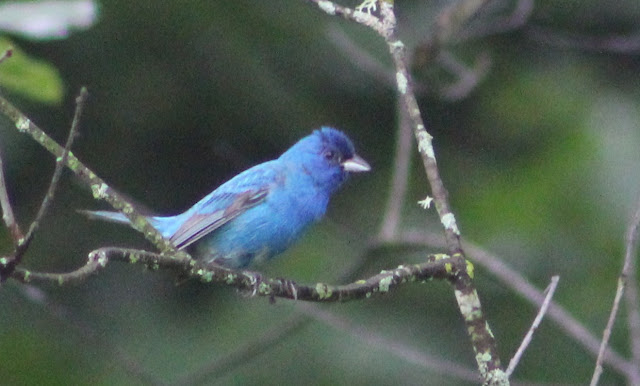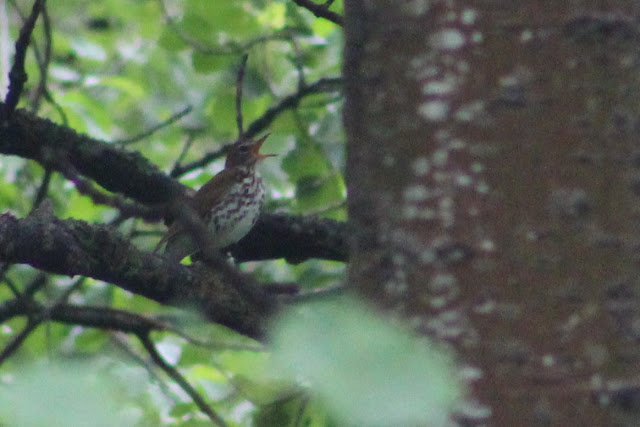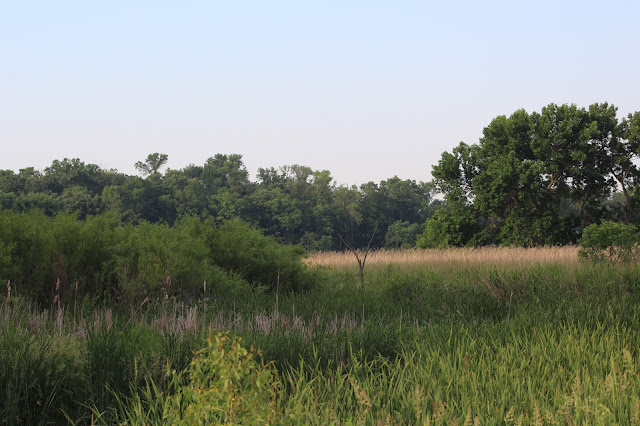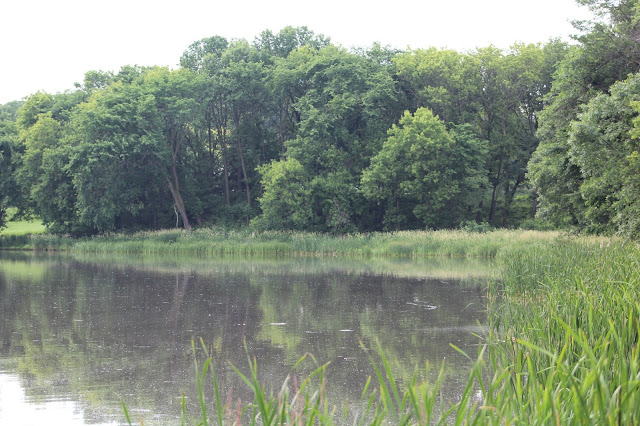Washburn County, Wisconsin, or the State of Wisconsin in general, is an awesome place. There are many things to do there. Perhaps Wisconsin is best known for it's epic dairy farms and dairy products such as ice cream, cheese, milk, cheese curds, and more. Here, four people wander through Shell Lake and Spooner, Wisconsin to get free ice cream that the local banks hand out on summer Fridays.
Wisconsin is also known for it's fishing. Walleye, Northern Pike, Muskie, Small and Largemouth Bass, you name it!
Another epic thing are water related activities. Boating. Rafting. Canoeing. You got it! There are lakes and rivers everywhere.
What's really cool is that I have family in Washburn County, Wisconsin, and that's why I was there.
My Grandma lives in Wisconsin. Pearl DeBardeleben and my Grandfather, the late John DeBardeleben, resided in the Spooner/Shell Lake area in Washburn County. For this reason, I've always loved this place. My aunt Tabby lives here as well as many second cousins and other relatives of my Dad's. We were here for a family project, and there was a lot of work involved. The family time was epic.
Wisconsin also has it's good birding too! And I, Tommy D, love birding in this state. Lots of birders do too.
Remember my post about Wisconsin's Warblers and the fact that I lifered on three of them during my recent trip: Blackburnian, Canada, and Mourning Warblers? I did add another lifer in Wisconsin, and that was a heard-only Black-billed Cuckoo. My brother Tyler and I went back after I heard it to try and relocate the bird and to get a visual of it, but it simply wasn't meant to be. With a Black-billed Cuckoo though, I'll take a heard-only.
In Washburn County, there were an assortment of birds away from the life birds. Many of them were classic birds from the east, and I will feature them on this post. Whether what I saw or not, it was cool to bird in a County that I've always wanted to bird in. In the week we spent and in the limited time I had for birding, I recorded 105 species in Washburn County. And it is a County that is heavily under-birded!
Things got really fun on the drive up and once we entered into Washburn County. This Bald Eagle was scavenging on a road killed deer. Ooohs and aaahs filled my family members voices.
The local Brown Thrasher was an awesome sight once we started working.
Sometimes, Sandhill Cranes were seen in the area's fields..
Here's the Eastern Kingbird, a classic eastern bird that haunts roadsides.
Yellow-throated Vireos are fairly common in northwestern Wisconsin. They are loud and are heard a lot more than they are seen. A few times on the trip, I found myself face-to-face with one.
Truly impressive were the numbers of the Veery throughout Washburn. They were everywhere. And so were their epic songs.
A lone Trumpeter Swan made it's home at a series of wetlands called Tozar Springs just off of the Yellow River. We drove by this place several times daily, and every time, this Trumpeter Swan was there.
One of the most abundant birds in the east is the Red-eyed Vireo. You can't go anywhere without hearing one!
An amazing highlight happened when I got to see this Broad-winged Hawk roadside. It was the first time I've really gotten to see this small buteo well after catching glimpses of a few on this trip and having brief looks at two separate Arizona migrants.
The Song Sparrows in the north look a lot different than the ones in the southwest, that's for sure!
Here's a crappy shot of an Eastern Bluebird, another classic eastern bird.
I heard and saw and few Eastern Towhees on the trip. One of them was very cooperative for my camera, and these are the best pics I have obtained of this species.
Scarlet Tanagers were pretty scarce while I was up there, but I managed to catch this striking bird at a distance. After all, this was my 500th life bird which I saw for the first time last year.
This male Rose-breasted Grosbeak in song sure was a welcoming sight.
The cat-like sounding Gray Catbird was very common on the trip. There were a few times individuals would perch out in the open for me.
Striking male Indigo Buntings were also a common sight, especially along the sides of roads or in forest clearings. I couldn't go anywhere without seeing these guys.
A few times on the trip, I heard the breathtaking song of the Wood Thrush. This song doesn't sound like anything we should hear on earth, and it all comes from a medium-sized brown bird with black spots on it's front. Prior to this trip, I caught one glimpse of a Wood Thrush as it flew away from me. This time, my patience in hoping to see one well prevailed, and I got good looks and decent photographs of this singing male on territory. These are my first Wood Thrush photographs!
The common and well-known Blue Jay is loud and can be heard everywhere in the East. Despite the common audio, these birds don't readily show themselves much. This individual was the only one who gave me a chance to view it on the trip.
This female Yellow-bellied Sapsucker was right outside my Aunt Gretchen and Uncle Larry's cabin. Another classic bird of the east..
As you can all see in a nutshell, this place is awesome for birding. If you haven't seen my Wisconsin Warblers post yet, it's two posts back in the archives. Washburn has it's warblers, and a lot of them at that. I hope to return to this awesome place again soon for family, for all the fun mentioned above, and of course, for the birds too.
Showing posts with label Wood Thrush. Show all posts
Showing posts with label Wood Thrush. Show all posts
Sunday, July 30, 2017
Washburn County, Wisconsin: A Great Place For Eastern Birding
Tuesday, June 21, 2016
Lake Elizabeth and a Restored Prairie
Day two of my Minnesota birding trip fell on June 10th, 2016. This second day was bound to be a crazy one as I would eventually head up north to North Dakota to spend time looking for Short-eared Owls (see previous post, TOBY Goes to North Dakota). But the first half of this second day resulted in some epic birding with Josh in more places in Kandiyohi County. After a packed-full first day of the trip, Josh and I took advantage of an extra hour of sleep instead of getting up at unholy hours. Josh decided to show me some places near home as well as some locations further south in Kandiyohi County. Once we hit the road, we were greeted by a few Ring-necked Pheasants near the road, who were crossing a railroad track.
The first destination Josh took me to was 75th Avenue in the Lake Elizabeth area. Lake Elizabeth was a beautiful place and held a lot of potential for things. Josh has had a lot in this area during his recent explorations. Because Lake Liz was surrounded by private property, we had to bird from the road. Despite our roadside limitations, the birds were cooperative and some of them provided us with amazing shows.
It wasn't long before we were greeted by a few Trumpeter Swans. Throughout the trip to Minnesota, the sight of the Swans became a regular thing. It was cool to hear them vocalizing at times, where the species gets its name from.
We were also greeted by this Snapping Turtle, which is one of the coolest reptiles I've ever seen. A few minutes were put aside to observe this neat animal. Josh said to not get too close to it, because it has a reason it is named Snapping Turtle..
A mix of wetland and woodland habitats gave us a variety of birds to search through.
Seeing a Rose-breasted Grosbeak on his breeding grounds was a neat sight. This was something I recently got lucky enough to see in Arizona just migrating through. A few times throughout the trip, our paths would cross with these stunning birds.
Once we really started to bird the thick deciduous woods, bird sound was everywhere. Rose-breasted Grosbeaks. Red-bellied and Pileated Woodpeckers. Eastern Wood-Pewee. Least Flycatcher. Eastern Phoebe. Yellow-throated and Red-eyed Vireos. Blue Jays. Gray Catbird. American Redstarts. Baltimore Oriole. American Goldfinch. Just a few. This Great-crested Flycatcher decided to finally pop up at a close range.
Looking down 75th Avenue resulted in seeing this White-tailed Deer family.
A sweet song and a flash of red later, we had an epic bird fly in and land in front of us.
Yep, it was a male Scarlet Tanager. This male Scarlet Tanager was at a territory along Lake Liz where Josh knew about it's whereabouts from last year. And this year, it was right were Josh said it would be. Words can't really describe how awesome this bird is. I'll leave a selection of photographs rather than words. I don't think words can do this bird justice anyways. But I will say, this Scarlet Tanager seemed to be reminding me how epic my 500th life bird was and that it will be a supreme bird to go down in my birding books.
After seeing an epic Scarlet Tanager, you've gotta wonder what else is awesome down the road further..
The answer was a Wood Thrush. But like my first Wood Thrush, this one played the same game. Josh and I stood by the road listening to the Wood Thrush and hoping to catch a glimpse of it by scanning all we could from the road. The Wood Thrush was close, but it was too well covered by the thick woodlands. However, the song was great to listen to, and I managed to get a recording of it to document the Wood Thrush's presence.
The sight of the male Bobolink was awesome, and this bird is distinct and striking. Duller females did pop into view several times, but the males constantly flew around while actively singing in flight. Just a few colors make the male Bobolink striking: the straw-colored nape, white rump, and all black front from top to bottom. The song of the male Bobolink flying over this prairie put me in a good mood.
Bobolinks can be very gregarious birds, especially in migration where flocks can number in the thousands. Here on their breeding grounds the numbers aren't that high, but these birds are still present in good numbers.
Josh really knew where to find birds on this trip, and the Bobolink was an example of that. Amazingly, this prairie habitat was a small patch of land and there wasn't a lot of it.
The first destination Josh took me to was 75th Avenue in the Lake Elizabeth area. Lake Elizabeth was a beautiful place and held a lot of potential for things. Josh has had a lot in this area during his recent explorations. Because Lake Liz was surrounded by private property, we had to bird from the road. Despite our roadside limitations, the birds were cooperative and some of them provided us with amazing shows.
It wasn't long before we were greeted by a few Trumpeter Swans. Throughout the trip to Minnesota, the sight of the Swans became a regular thing. It was cool to hear them vocalizing at times, where the species gets its name from.
We were also greeted by this Snapping Turtle, which is one of the coolest reptiles I've ever seen. A few minutes were put aside to observe this neat animal. Josh said to not get too close to it, because it has a reason it is named Snapping Turtle..
A mix of wetland and woodland habitats gave us a variety of birds to search through.
Seeing a Rose-breasted Grosbeak on his breeding grounds was a neat sight. This was something I recently got lucky enough to see in Arizona just migrating through. A few times throughout the trip, our paths would cross with these stunning birds.
Once we really started to bird the thick deciduous woods, bird sound was everywhere. Rose-breasted Grosbeaks. Red-bellied and Pileated Woodpeckers. Eastern Wood-Pewee. Least Flycatcher. Eastern Phoebe. Yellow-throated and Red-eyed Vireos. Blue Jays. Gray Catbird. American Redstarts. Baltimore Oriole. American Goldfinch. Just a few. This Great-crested Flycatcher decided to finally pop up at a close range.
Looking down 75th Avenue resulted in seeing this White-tailed Deer family.
A sweet song and a flash of red later, we had an epic bird fly in and land in front of us.
Yep, it was a male Scarlet Tanager. This male Scarlet Tanager was at a territory along Lake Liz where Josh knew about it's whereabouts from last year. And this year, it was right were Josh said it would be. Words can't really describe how awesome this bird is. I'll leave a selection of photographs rather than words. I don't think words can do this bird justice anyways. But I will say, this Scarlet Tanager seemed to be reminding me how epic my 500th life bird was and that it will be a supreme bird to go down in my birding books.
After seeing an epic Scarlet Tanager, you've gotta wonder what else is awesome down the road further..
The answer was a Wood Thrush. But like my first Wood Thrush, this one played the same game. Josh and I stood by the road listening to the Wood Thrush and hoping to catch a glimpse of it by scanning all we could from the road. The Wood Thrush was close, but it was too well covered by the thick woodlands. However, the song was great to listen to, and I managed to get a recording of it to document the Wood Thrush's presence.
Someday I'll see a Wood Thrush! For now I'll remember it's song, one of Nature's best. Near the Wood Thrush, some other birds did pop into view after lingering in the thick deciduous woodlands. One of them was this Yellow-throated Vireo.
And another was this Eastern Wood-Pewee. This EWPE's distinct song carries a long ways, and it is commonly heard in any of these woodland settings.
The Lake Liz area was awesome. Josh also has heard another life bird of mine that I really want in this area, the Black-billed Cuckoo.
From Lake Liz, we continued southwest further into Kandiyohi County to explore some grasslands, agricultural area, ponds, and a small chunk of prairie. En route we had our eyes peeled for Red-headed Woodpeckers, which was a potential life bird for me and was one Josh hadn't seen in the County in some time. Several Eastern Kingbirds along the way was fun for me.
One stop was at Blomkest Wastewater Treatment Plant where Josh has found some neat birds including Gray Partridge along the fenced perimeters of the Plant. That was one of our morning targets. After walking around the plant, we couldn't kick up any of the Partridges. That was a bird I would have a shot at later in the trip, so I didn't worry about it too much. This male American Goldfinch in the area was awesome.
In the closing hour of our exploration, Josh and I went to a restored prairie area where Josh has seen another big life bird hopeful of mine, the Bobolink. Once we entered the area the habitat looked great, and I could see why Josh had Bobolink there. Rolling down the window and listening resulted in hearing the Clay-colored Sparrow's buzzy songs. As we started to scan, it didn't take very long to find that awesome Bobolink! The Bobolink was my 13th life bird of the trip already on just the second morning. Minnesota was treating me well!
The sight of the male Bobolink was awesome, and this bird is distinct and striking. Duller females did pop into view several times, but the males constantly flew around while actively singing in flight. Just a few colors make the male Bobolink striking: the straw-colored nape, white rump, and all black front from top to bottom. The song of the male Bobolink flying over this prairie put me in a good mood.
Bobolinks can be very gregarious birds, especially in migration where flocks can number in the thousands. Here on their breeding grounds the numbers aren't that high, but these birds are still present in good numbers.
Josh really knew where to find birds on this trip, and the Bobolink was an example of that. Amazingly, this prairie habitat was a small patch of land and there wasn't a lot of it.
Despite the Bobolink excitement, a Sedge Wren popped up and stole some of the time with the Bobolinks. I never thought I would crush a Sedge Wren with photos. As soon as I saw the Sedge Wren singing, I put off looking at Bobolinks for a few minutes.
The restored prairie was a neat habitat to bird in.
The morning of birding Kandiyohi County in the morning was great. Thanks Josh!
Subscribe to:
Posts (Atom)



























































































